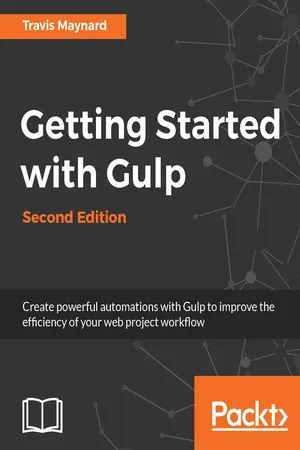
- 132 pages
- English
- ePUB (mobile friendly)
- Available on iOS & Android
Getting Started with Gulp – Second Edition
About This Book
Create powerful automations with Gulp to improve the efficiency of your web project workflowAbout This Book• Gain a solid understanding of Gulp and write your own custom tasks from scratch• Discover ways to add additional functionality to improve your tasks• Get up-and-running with new features added to the latest version of GulpWho This Book Is ForThis book is targeted at developers who are new to build systems and task runners but who have had prior experience with web development; a basic knowledge of HTML, CSS, and JavaScript is assumed. It guides the reader through the process of using Gulp to automate several common development tasks so that they can save time and focus on what is most important: writing great code.What You Will Learn• How to use a command-line interface.• Learn about Gulp, Node.js, and npm and how they work together.• Create a Gulpfile from scratch and implement it into a project.• Write basic tasks that will concatenate, minify, compress, and pre-process your files.• Write advanced tasks that will run a local server, sync file changes to your browser, and allow you to write client-side JavaScript using ES2015.In DetailThis book is a hands-on guide to get you up to speed with gulp. You will quickly learn how to install, configure, and run your own build system. It will instill you with the ability to automate several common development tasks to vastly improve your development workflow. This book first demonstrates various Gulp use cases before running through the steps of configuring, running, and customizing Gulp, providing you with core concepts of gulp, node.js, and npm. Diving a bit deeper into the gulp ecosystem, we will discuss when and why to use a node module instead of a gulp plugin. We will also go over a few issues that we can run into while using gulp and learn about ways to work around them to improve your gulp experience.By the end of this book, you will be able to create your very own gulp build from scratch, create and maintain tasks and project builds, and automate your workflow with plugins and custom tasks.Style and approachA step-by-step guide to help you get started with the latest features
Frequently asked questions
Information
Creating Advanced Tasks
Using plain Node.js modules
Why use plain Node.js modules?
Static server
Installing modules
npm install connect serve-static --save-dev

Including modules
// Load Node Modules/Plugins
var gulp = require('gulp');
var concat = require('gulp-concat');
var myth = require('gulp-myth');
var uglify = require('gulp-uglify');
var jshint = require('gulp-jshint');
var imagemin = require('gulp-imagemin');
var connect = require('connect'); // Added
var serve = require('serve-static'); // Added

Writing server task
// Server Task
gulp.task('server', function() {
return connect().use(serve(__dirname))
.listen(8080)
.on('listening', function() {
console.log('Server Running: View at http://localhost:8080');
});
});

Table of contents
- Title Page
- Copyright
- Credits
- About the Author
- About the Reviewer
- www.PacktPub.com
- Customer Feedback
- Preface
- Introducing Gulp
- Getting Started
- Understanding the Basics of Gulp
- Performing Tasks with Gulp
- Creating Advanced Tasks
- Tips, Tricks, and Resolving Issues